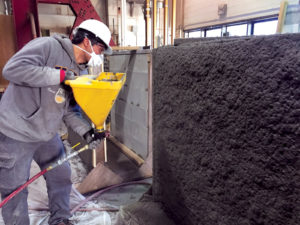
What material could help buildings stand up to earthquakes? Fiber, of course. Researchers at the University of British Columbia have developed concrete reinforced with fiber that can withstand earthquake simulation tests.
The material, called eco-friendly ductile cementitious composite (EDCC), is engineered at the molecular level to be strong yet malleable. When applied as a thin coating on the surface of existing walls, it’s capable of boosting the earthquake resistance of a seismically vulnerable structure.
The researchers tested the strength of the material by conducting trials that simulate the power of earthquakes. The team sprayed the test walls with a 10-millimeter-thick layer of EDCC, which is sufficient to reinforce most interior walls against seismic tremors. The material withstood shocks as intense as the magnitude 9.0–9.1 earthquake that struck Tohoku, Japan, in 2011.
EDCC, which combines cement with polymer-based fibers, fly ash and other industrial additives, is also eco-friendly. Cement production is a contributor to global greenhouse gas emissions—one ton of carbon dioxide is released for one ton of cement produced. By replacing nearly 70 percent of cement with fly ash, emissions can be reduced.
The material has been added as an official option in British Columbia’s seismic retrofit program and is now being used in the retrofit of a Vancouver elementary school. There are also plans to retrofit a school in northern India as part of a collaboration with Canada-India Research Centre of Excellence, the project funder. For more details, visit www.news.ubc.ca/tag/edcc.
 TEXTILES.ORG
TEXTILES.ORG


